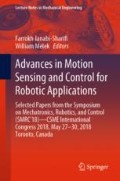Abstract
The current paper investigates a sliding mode controller for stabilizing a two-wheel inverted pendulum (TWIP) robot. It is well-known that the controller in the mobile robot plays a critical role in self-balancing and stabilizing. The TWIP robot has two DC gear motors with a high-resolution encoder and zero backlash, but with friction. It is a highly nonlinear and unstable system, which poses challenges for controller design. In this study, a mathematical dynamic model is built using Lagrangian function method. And a sliding mode controller (SMC) is proposed for auto-balancing and yaw rotation. A gyro and an accelerometer are adopted to measure the pitch angle and pitch rate. The effect on the sensors installation location was analyzed and compensated, and the precision of the pose estimation is improved accordingly. A comparison of the proposed SMC controller with proportional-integral-derivative (PID) controller and state feedback controller (SFC) with linear quadratic regulation (LQR) has been conducted. The experimental test results demonstrate the SMC controller outperforms PID controller, SFC and SMC controller in Zhang and Li (Proceedings of 35th Chinese control conference (CCC). IEEE) [14] in terms of transient performance and disturbance rejection ability.
Access this chapter
Tax calculation will be finalised at checkout
Purchases are for personal use only
References
Nasir ANK, Ahmad MA, Ismail RR (2010) The control of a highly nonlinear two-wheels balancing robot: A comparative assessment between LQR and PID-PID control schemes. World Acad Sci Eng Technol 70:227–232
Marzi H (2006) Fuzzy control of an inverted pendulum using AC induction motor actuator. In: Proceedings of IEEE international conference on computational intelligence for measurement systems and applications. IEEE, July 2006
Tsai CC, Ju SY, Hsieh SM (2010) Trajectory tracking of a self-balancing two-wheeled robot using backstepping sliding-mode control and fuzzy basis function networks. In: Proceedings of IEEE/RSJ international conference on intelligent robots and systems (IROS). IEEE, October 2010
Unluturk A, Aydogdu O (2017) Adaptive control of two-wheeled mobile balance robot capable to adapt different surfaces using a novel artificial neural network–based real-time switching dynamic controller. Int J Adv Rob Syst 14(2):1729881417700893
Villacres J, Viscaino M, Herrera M et al (2016) Controllers comparison to stabilize a two-wheeled inverted pendulum: PID, LQR and sliding mode control. Moment 2(2):12
Gans NR, Hutchinson SA (2006) Visual servo velocity and pose control of a wheeled inverted pendulum through partial-feedback linearization. In: Proceedings of IEEE/RSJ international conference on intelligent robots and systems. IEEE, October 2006
ul Hasan M, Hasan KM, Asad MU et al (2014) Design and experimental evaluation of a state feedback controller for two wheeled balancing robot. In: IEEE 17th international multi-topic conference (INMIC). IEEE, December 2014
Chen ML (2012) Analysis and design of robust feedback control systems for a nonlinear two-wheel inverted pendulum system. In: Proceedings of international symposium on computer, consumer and control. IEEE, June 2012
Nomura T, Kitsuka Y, Suemitsu H et al (2009). Adaptive backstepping control for a two-wheeled autonomous robot. In: Proceedings of ICCAS-SICE. IEEE, August 2009
Pathak K, Franch J, Agrawal SK (2005) Velocity and position control of a wheeled inverted pendulum by partial feedback linearization. IEEE Trans Rob 21(3):505–513
Pathak K, Franch J, Agrawal SK (2004) Velocity control of a wheeled inverted pendulum by partial feedback linearization. In: Proceedings of 43rd IEEE conference on decision and control. IEEE, December 2004
Huang J, Guan ZH, Matsuno T et al (2010) Sliding-mode velocity control of mobile-wheeled inverted-pendulum systems. IEEE Trans Rob 26(4):750–758
Yue M, Sun X, Li N et al (2015) Dynamic motion planning and adaptive tracking control for a class of two-wheeled autonomous vehicle with an underactuated pendular suspension. J Dyn Syst Meas Contr 137(10):101006
Zhang Z, Li L (2016) Design and implementation of two-wheeled mobile robot by variable structure sliding mode control. In: Proceedings of 35th Chinese control conference (CCC). IEEE, July 2016
Esmaeili N, Alfi A, Khosravi H (2017) Balancing and trajectory tracking of two-wheeled mobile robot using backstepping sliding mode control: design and experiments. J Intell Rob Syst 87(3–4):601–613
Lv W, Kang Y, Zhao P (2013) Speed and orientation control of a two-coaxial-wheeled inverted pendulum. In: Proceedings of 32nd Chinese control conference (CCC). IEEE, July 2013
Dai F, Gao X, Jiang S et al (2015) A two-wheeled inverted pendulum robot with friction compensation. Mechatronics 30:116–125
Thao NGM, Nghia DH, Phuc NH (2010). A PID backstepping controller for two-wheeled self-balancing robot. In: International forum on strategic technology (IFOST). IEEE, October 2010
Velazquez M, Cruz D, Garcia S et al (2016) Velocity and motion control of a self-balancing vehicle based on a cascade control strategy. Int J Adv Rob Syst 13(3):106
Author information
Authors and Affiliations
Corresponding author
Editor information
Editors and Affiliations
Rights and permissions
Copyright information
© 2019 Springer Nature Switzerland AG
About this paper
Cite this paper
S. Arani, M., Ebrahimi Orimi, H., Xie, WF., Hong, H. (2019). Sliding Mode Control Design of a Two-Wheel Inverted Pendulum Robot: Simulation, Design and Experiments. In: Janabi-Sharifi, F., Melek, W. (eds) Advances in Motion Sensing and Control for Robotic Applications. Lecture Notes in Mechanical Engineering. Springer, Cham. https://doi.org/10.1007/978-3-030-17369-2_7
Download citation
DOI: https://doi.org/10.1007/978-3-030-17369-2_7
Published:
Publisher Name: Springer, Cham
Print ISBN: 978-3-030-17368-5
Online ISBN: 978-3-030-17369-2
eBook Packages: Intelligent Technologies and RoboticsIntelligent Technologies and Robotics (R0)

